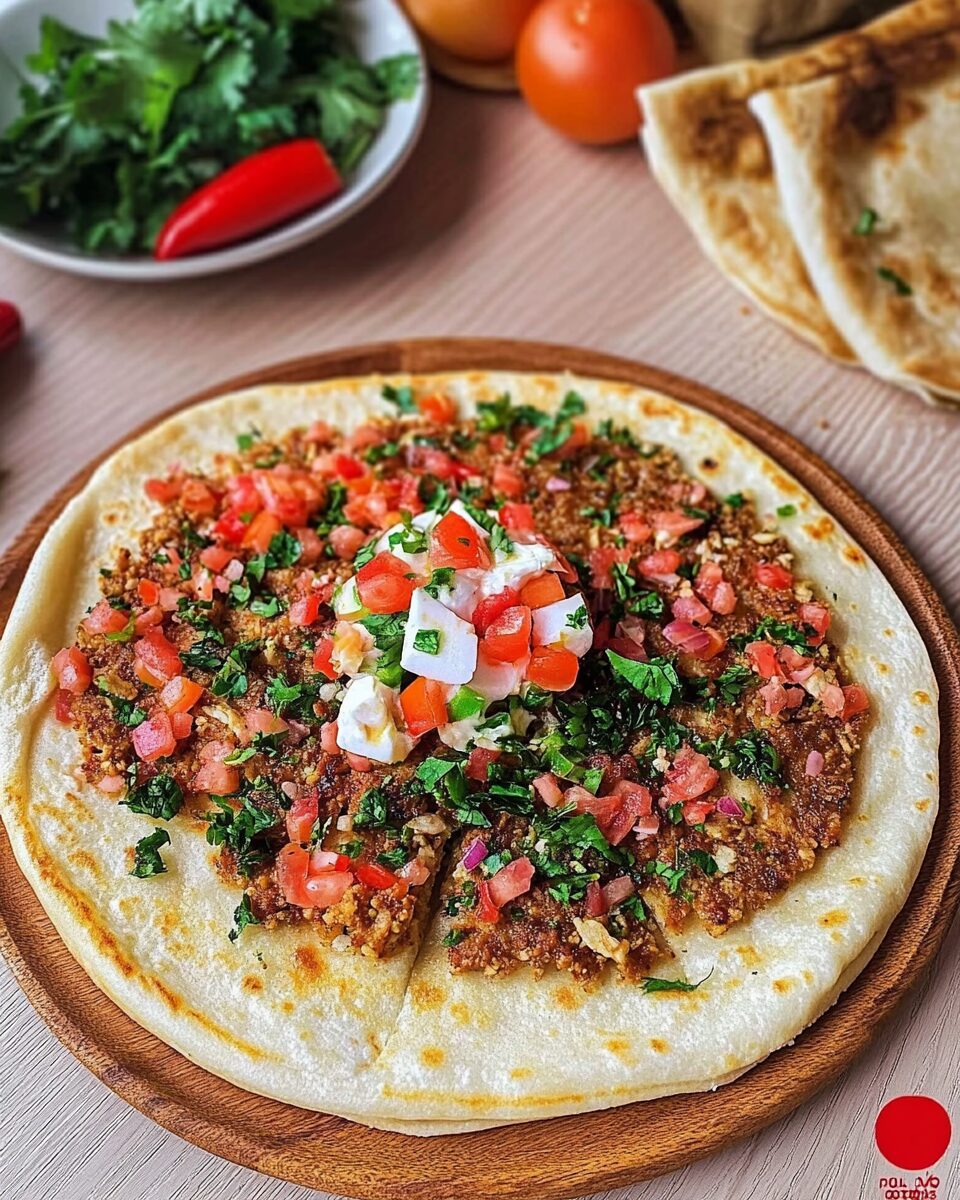Lahmacun is often referred to as “Turkish pizza,” a delightfully thin and crispy flatbread topped with a flavorful blend of minced meat, tomatoes, herbs, and spices. It is a staple street food across Turkey and the Middle East, known for its simplicity and rich taste. This recipe brings that authentic experience to your kitchen, offering a savory, aromatic meal that’s quick to prepare yet deeply satisfying.
Perfect for a casual lunch or dinner, Lahmacun pairs beautifully with fresh parsley, lemon wedges, and crisp salads. It’s a versatile dish that can be rolled up and eaten by hand or served as a shareable appetizer. Making it from scratch allows you to control every ingredient and customize the spice level to suit your palate, making it an excellent choice for food lovers looking to explore global flavors at home.
Full Recipe:
2 cups all-purpose flour
1 teaspoon salt
1 teaspoon sugar
1 teaspoon dry yeast
3/4 cup warm water
2 tablespoons olive oil
For the topping:
250g (9 oz) ground lamb or beef
1 small onion, finely chopped
2 cloves garlic, minced
1 large tomato, finely diced
1/2 cup fresh parsley, finely chopped
1/2 cup bell pepper, finely chopped (red or green)
1 tablespoon tomato paste
1 teaspoon ground cumin
1 teaspoon paprika
1/2 teaspoon chili flakes (optional)
Salt and black pepper, to taste
Directions:
In a mixing bowl, combine flour, salt, sugar, and yeast. Slowly add warm water and olive oil, kneading until you form a soft, elastic dough. Cover and let rise in a warm place for about 1 hour or until doubled in size.
While dough rises, prepare the topping by mixing ground meat, onion, garlic, tomato, parsley, bell pepper, tomato paste, cumin, paprika, chili flakes, salt, and pepper in a bowl. Mix well to combine.
Preheat oven to 475°F (245°C). If you have a pizza stone, place it in the oven to heat.
Divide dough into 4 equal portions. Roll each portion out thinly on a floured surface into a circle about 10 inches in diameter.
Spread a thin, even layer of the meat mixture over each dough circle.
Place the flatbreads on a baking sheet or directly on the pizza stone and bake for 8-10 minutes or until the edges are crispy and the meat is cooked through.
Serve hot, traditionally rolled with fresh parsley, lemon wedges, and sometimes a side of yogurt or salad.
Prep Time: 20 minutes | Cooking Time: 10 minutes | Total Time: 1 hour 30 minutes (including rising)
Kcal: Approximately 280 kcal per serving | Servings: 4 servings
Introduction to Lahmacun: A Culinary Delight from Turkey
Lahmacun is a beloved dish originating from Turkey, often described as Turkish pizza due to its round, flat shape and savory topping. However, this simple comparison doesn’t do justice to its rich cultural history and unique flavors. Traditionally, lahmacun consists of a thin, crispy flatbread base generously topped with a mixture of minced meat—usually lamb or beef—combined with a medley of fresh vegetables, herbs, and spices. This combination creates an irresistible balance of textures and tastes that has made lahmacun a staple street food and home-cooked favorite across Turkey and the broader Middle Eastern region.
What sets lahmacun apart from other flatbreads or pizzas is its exceptionally thin crust and the fresh, vibrant toppings. Unlike cheese-laden pizzas, lahmacun focuses on the aromatic blend of spices and fresh ingredients that highlight the savory, juicy qualities of the meat topping. The dough is usually rolled paper-thin, baked quickly at high heat to achieve a crispy, light texture that acts as a perfect canvas for the flavorful topping.
Historical and Cultural Significance
Lahmacun has deep roots in Middle Eastern and Anatolian culinary traditions. It is believed to have originated from the southeastern regions of Turkey and then spread across the Middle East due to the Ottoman Empire’s vast cultural influence. The dish was originally a way for families to use simple, readily available ingredients to create a filling and nutritious meal.
Over time, lahmacun evolved into a street food icon, sold in small bakeries and street stalls where the aroma of freshly baked flatbread and spiced meat entices locals and travelers alike. It’s commonly enjoyed as a quick lunch or light dinner, often paired with fresh herbs like parsley and a squeeze of lemon juice to add brightness and acidity. The way it is eaten also varies; many roll it up like a wrap for convenience, making it easy to enjoy on the go.
The Flavor Profile and Ingredients
The magic of lahmacun lies in the perfect marriage of its toppings. The minced meat is typically mixed with finely chopped onions, garlic, tomatoes, bell peppers, and fresh parsley, all bound together with tomato paste and an array of warm spices such as cumin, paprika, and sometimes a hint of chili for subtle heat. These spices add depth and complexity, transforming simple ingredients into a deeply savory and aromatic topping.
The freshness of the vegetables and herbs complements the rich, meaty flavor, while the tomato paste adds a slight tanginess that balances the dish. The use of fresh parsley and a squeeze of lemon juice right before eating brightens up the whole dish, making each bite refreshing and satisfying.
Dough and Baking Technique
The dough for lahmacun is key to its signature texture. It is made with basic pantry staples like flour, water, yeast, sugar, salt, and olive oil. The process involves kneading the dough until it’s soft and elastic, then allowing it to rise. The dough is then divided and rolled out incredibly thin, thinner than most pizzas, to achieve that crispy, almost cracker-like crust once baked.
Baking at a very high temperature, often in a wood-fired oven or a very hot conventional oven, ensures the dough cooks quickly and crisply without drying out. This technique locks in the moisture of the meat topping while giving the base a satisfying crunch.
Serving Suggestions and Variations
Lahmacun is traditionally served with fresh parsley, thinly sliced onions, and lemon wedges. These simple accompaniments help to cut through the richness of the meat and add layers of fresh, zesty flavors. Some like to add a drizzle of yogurt or a light salad of tomatoes and cucumbers to round out the meal.
While the classic version uses lamb or beef, there are many variations to accommodate dietary preferences. Some recipes incorporate ground chicken or turkey for a lighter version, while vegetarian options substitute the meat with spiced lentils, mushrooms, or finely chopped vegetables. In different regions, the spice blends and toppings can vary, reflecting local tastes and ingredient availability.
Nutritional Benefits
Lahmacun, when made with fresh ingredients and lean meat, can be a balanced and nutritious meal. It provides a good source of protein from the meat and important vitamins and antioxidants from the vegetables and herbs. The thin crust keeps the calorie count moderate compared to thicker, cheese-heavy pizzas, making it a great option for those mindful of their diet but who still crave rich flavors.
Incorporating fresh parsley and lemon not only enhances flavor but also boosts vitamin C and adds antioxidants, contributing to a healthier meal overall.
Popularity Beyond Turkey
The appeal of lahmacun has spread beyond Turkey and the Middle East, gaining fans worldwide due to its delicious taste and versatility. It is increasingly featured in Middle Eastern and Mediterranean restaurants globally and is embraced by food lovers seeking authentic, flavorful ethnic dishes.
Its quick preparation time and ability to be customized make lahmacun perfect for home cooks and foodies who enjoy exploring international cuisines without the need for complicated cooking techniques or hard-to-find ingredients.
Tips for Making the Perfect Lahmacun at Home
To replicate the authentic experience at home, focus on a few key details. First, ensure the dough is rolled as thin as possible for that delicate crunch. Second, finely chop the topping ingredients and mix them well so the flavors meld beautifully. Finally, bake at the highest possible temperature for a short time to achieve the perfect texture and doneness.
Don’t rush the dough rising process, as it’s crucial for a soft yet crispy crust. And remember, fresh accompaniments like lemon, parsley, and raw onions are essential—they elevate the finished dish to its full potential.
Conclusion
Lahmacun is more than just a dish; it is a cultural symbol and a celebration of Middle Eastern culinary heritage. Its simple ingredients and straightforward preparation hide the complexity of flavors that come together in every bite. Whether enjoyed on the streets of Istanbul or made in your own kitchen, lahmacun offers a delicious, wholesome, and versatile meal option.
For food lovers seeking to expand their palate, lahmacun is a perfect introduction to Turkish cuisine—combining fresh ingredients, bold spices, and satisfying textures into one unforgettable dish. With endless variations and a rich history, it’s no wonder this flatbread remains a favorite across generations and continents. Give lahmacun a try, and you may just find a new comfort food to cherish.






